

The Government’s plan for exiting the coronavirus lockdown targeted 4 July as the earliest date from which the hospitality sector could start to reopen.
While some pubs and restaurants remained open during lockdown for limited takeaway orders, this has not been economically viable for most pubs, bars, cafes and restaurants and in some cases not possible at all.
The biggest challenge stems from accommodating the social distancing rules, as these establishments tend to be based on high turnover, low margin models. Another key factor that we are facing is the public’s confidence to return safely, in high numbers. We have spent the last three months practicing social distancing and adapting to hygienic safety measures, so we will need to be confident that each social environment is 100% Covid-compliant.
We have created a Covid-19 Compliant Pub or Restaurant layout taking into account the measures which have been discussed and developed by Government officials and professionals from the hospitality industry.
So, what should be expected?
On arrival and prior to entering, customers may be greeted by a member of staff who will be known as a ‘Pub Host’. Their role will be to welcome customers, show them to their tables and manage queues. There may also be a member of staff known as the ‘Pub Safe Monitor’ who will be responsible for maintaining levels of hygiene to keep customers safe. The Pub Safe Monitor will also be a clear point of contact for customers or members of staff who wish to raise any concerns surrounding hygiene levels.
Staff wearing masks and gloves
If British pubs follow the lead of other European establishments that have already reopened their doors; Pub Hosts, Pub Safe Monitors and other members of staff would need to wear facemasks. Bar staff should also wear latex gloves when it comes to pouring pints or making cocktails.
Contactless ordering using apps
To minimise congestion at the bar, encourage customers to order food and drink via an app on their mobile phones. This has already been implemented by Wetherspoons, prior to the Covid-19 pandemic, and has proven to be extremely successful. The Hungrrr app is one example which allows customers with an iPhone or android phone to order food and drinks without leaving their seat.
A reduction of tables and chairs, creating more space
In order to manage social distancing, existing restaurant furniture, Café tables and dining chairs will be reduced, reconfigured and spaced out.
An increase in al fresco dining, outdoor furniture, and market style food stalls
In response to managing social distancing effectively in pubs and restaurants, Government ministers are drawing up plans to relax outdoor seating licenses within weeks. This potentially could entail closing some roads to allow for extra tables and chairs to be utilised and lifting some pavement restrictions. The local high street may soon resemble the al fresco cafes and bars in Spain, France or Italy. Consider purchasing outdoor furniture to help with increasing table numbers in the sunshine or a parasol in case it rains.
An Increase in Protective Floor Screens
During the beginning stages of lockdown, many architects and interior designers created conceptual ideas of work establishments, schools, pubs, cafes, and restaurants post lockdown. Some of these ideas were quite alarming, featuring clinical looking acrylic or glass screens at every turn or point of contact. Suppliers and manufacturers are now designing and manufacturing screens that are ‘warm’ and ‘friendly’, with rustic wood or leather panels ideal for the hospitality industry. Our Protect Express Protection Screens feature a black frame and lower panel in a choice of Marble, Oak, Rustic Wood or Chesterfield leather effect which will compliment several different environments.
Another type of screen that has been popular is the Future Protection Mobile Goal Post screen and Protect Floor Standing Wooden Goal Post Screen. These screens are lightweight as the lower area remains open, almost halving the weight of a standard full panel screen and allowing for wrapped cutlery, condiments, or single use menus to be passed through if necessary. This is a suitable lightweight solution for when you need to configure spaces or seating areas quickly and easily. The wheeled castor feet mean they can effortlessly be pushed along.
A one-way system
It is likely that you will need to ask customers to follow a one-way system and will not be allowed to leave through the entrance, only through clearly marked exit points. Toilets may also require a one in, one out policy, potentially utilising a traffic light system.
Those restaurants and pubs which can adapt to the new environment quickly and easily should be able to recreate the ‘pub and dining experience’ without too much compromise.
Ben Hartley, Design Lead at Cafe Reality https://www.


